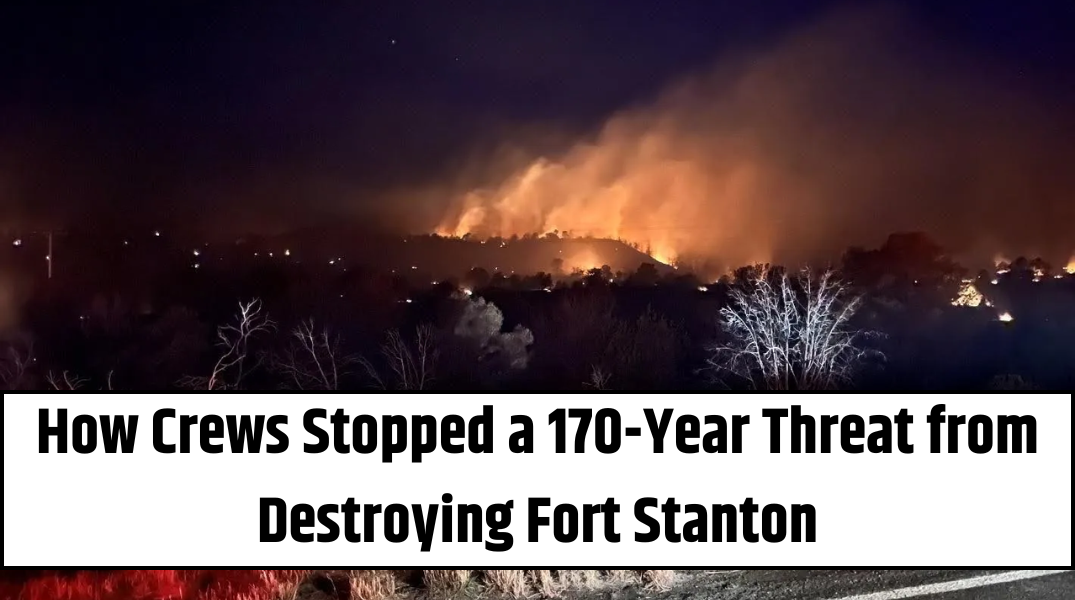During Fort Stanton’s annual celebration this August, the historic military outpost in southeastern New Mexico was alive with echoes of the past — Civil War re-enactors marching in formation, Mescalero Apache dancers preparing for a ceremonial performance, and visitors gathered under the late summer sun. Yet, amid the festivities, the event carried a deeper meaning this year: gratitude.
Standing on the stoop of the fort’s old guardhouse, site manager Oliver Horn looked over the crowd and gestured toward a line of firefighters assembled nearby. “There was a real chance that we would have lost this amazing location, a cornerstone of New Mexico’s heritage, if it weren’t for them,” Horn said, acknowledging the men and women who fought to save Fort Stanton from a devastating wildfire earlier in the year.
A Fort with Layers of History
Founded in 1855, Fort Stanton originally served as a U.S. Army post during conflicts with the Mescalero Apache. Over the years, it evolved through numerous identities: a hospital for tuberculosis patients, a Civilian Conservation Corps site, and even a World War II internment camp for German sailors. Figures such as Billy the Kid, Kit Carson, and Buffalo Soldiers once walked its grounds, leaving behind a complex legacy that reflects the history of the American West.
In May 2025, this legacy came dangerously close to being erased. The Camp Fire, driven by dry conditions and high winds, ignited near the Rio Bonito valley and spread rapidly toward the fort. Within hours, the fire had consumed hundreds of acres and destroyed several historic outbuildings, including a 1930s gymnasium used by interned sailors and two wooden structures built by the Civilian Conservation Corps.
Horn recalled receiving the call that flames were moving toward the fort. “I just needed a few more years,” he said — time to complete a long-term fire mitigation plan that included restoring irrigation channels, replacing flammable trees, and upgrading infrastructure.
Also Read – Cloudcroft Fall Forecast: Vibrant Leaves and New Business Buzz
The Battle to Save a Landmark
According to official accounts, Lincoln County Fire Chief Jake Canavan and County Manager Arron Griewahn were among the first to respond after a local resident reported smoke near the fort on May 24. Realizing the fire’s potential for devastation, they immediately called for reinforcements from across the county.
Soon, more than 150 firefighters from local volunteer departments, the New Mexico Forestry Division, the Forest Service, and the Bureau of Land Management joined forces. A helitack Hotshot crew from Mississippi was also deployed to assist with aerial suppression efforts.
Fueled by juniper and piñon trees, the blaze raced through the valley. Yet, thanks to years of investment in fire prevention — including new hydrants, upgraded water systems, and vegetation thinning — firefighters managed to hold the fireline just short of the fort’s main complex.
“It could have been catastrophic,” Canavan said. “If even one ember had landed on those old wood-shake roofs, we might have lost everything. But the water infrastructure gave us a fighting chance.”
By May 29, the fire was 87 percent contained, having burned roughly 875 acres. Though some outbuildings were lost, the fort’s most significant structures — its chapel, barracks, and officers’ quarters — remained intact.
A Fire 170 Years in the Making
After the fire, Horn reflected on the broader historical context that made the landscape so vulnerable. He described the blaze as “a fire 170 years in the making,” pointing to ecological changes that began when Kit Carson’s troops forced the Mescalero Apache from the area in the 1860s.
For centuries, the Mescalero had used controlled burns to maintain the grasslands and prevent large wildfires. Once displaced, ranchers moved in, introducing livestock that destroyed native grasses and allowed junipers and piñons to flourish unchecked.
Then came the Dust Bowl of the 1930s, when the U.S. Department of Agriculture encouraged planting Siberian elms — fast-growing trees meant to reduce erosion. Over time, these trees became invasive, choking out native vegetation and creating a highly combustible environment around Fort Stanton.
“Those elms were well-intentioned,” Horn said, “but now they’re a hazard. Communities all across New Mexico are struggling with how to remove them.”
Investments in Protection and Preservation
In recent years, the New Mexico Department of Cultural Affairs has invested nearly $8 million to protect and restore Fort Stanton. That includes $3.5 million in water system upgrades, installation of 17 fire hydrants, and the replacement of flammable roofs with synthetic materials. A $300,000 federal grant will fund the removal of invasive elms and replanting with native oaks.
Meanwhile, the Bureau of Land Management has performed more than 140 fuel treatments in the surrounding area since 1995, with one-third completed in just the past five years. These efforts have already paid dividends — helping firefighters contain the Camp Fire before it reached the fort’s historic core.
Also Read – How Free Early Childcare Could Spark a Surge in Enrollment
Lessons and a Sense of Victory
For Lincoln County officials, the successful defense of Fort Stanton was a rare moment of triumph in a region scarred by recent wildfires, such as the McBride Fire (2022) and the South Fork and Salt Fires (2024), which devastated nearby Ruidoso.
“It felt good to finally win,” Griewahn said, standing on a ridge overlooking the blackened valley where the Camp Fire burned. “For once, we met our objectives — we saved lives, property, and history.”
Canavan added that the fire prevention measures around Fort Stanton have even had economic benefits. Several local homeowners recently told him that their insurance premiums had dropped thanks to improved fire safety ratings — a rare outcome in a region where rates are otherwise rising sharply.
A Celebration of Resilience
Back at the August celebration, Horn presented plaques to the firefighters who saved the fort, recognizing their “exemplary actions in protecting and preserving New Mexico’s history.” The moment was emotional — a reminder that history isn’t just preserved in museums or archives but through the courage and coordination of those who protect it.
As the day ended, children ran through the courtyard where Buffalo Soldiers once drilled, playing under a softly fluttering American flag. For a site that has endured wars, epidemics, and now wildfires, Fort Stanton stood as a symbol of endurance — its story carried forward by those determined to keep its legacy alive.




